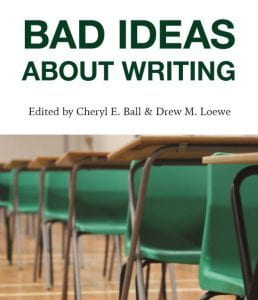Has it ever been a time you were excited about a paper that you had to turn in and anxiously waited for your grades back from your professor. Then, weeks later you get your grades and feedback just to be disappointed to see your teacher didn’t like your paper as much as you did. It’s not a good feeling. Professors and teachers don’t think about the damage their feedback actually does to the student. Instead of professors trying to give paragraph long responses to student’s writing doing one on one conferences with their students to converse about their paper could be a better idea. It gives students a better outlook and understanding on the things they should work on in their writing.

Bryon Wiegand, Associate Professor of Meat Science. Photo by Kyle Spradley | © 2014 – Curators of the University of Missouri
As students, we care the more we see our professor care. Professors might not be aware, but we pay close attention to the certain things our professors do and don’t do. To us, students, the over-grading of our papers is you, the professor, jotting down a bunch of negative things trying to tell us all of the things we’ve done wrong. In the article Bad Ideas About Writing, Muriel Harris, points out “some students react negatively because they are convinced that a lot of comments equals a lot of criticism” (Harris, 268). He’s trying to bring out that students won’t even actually read what the professor has written and automatically assume that the professor is picking at their paper. That is why written feedback can be risky. In the beginning of that specific page Harris begins to explains what teachers expect the students to get out of the written feedback. Then, towards the end of the page he gets into how students view the written feedback. Chris Anson, in his book Writing and Response: Theory, Practice, and Research, confirms that intense grading can lead students feeling like the teacher serves as just the hostile reader making writing seem less of a pursuit of meaning (Anson,78). If a student constantly feels like their writing is being judged they’ll become discouraged and stray away from the main purpose of writing. That is why even during the conference meetings the professor should focus only on the few major concerns to not overwhelm the student.
In addition, according to recent SAT scores critical reading scores dropped to its lowest since the SAT test was overhauled in 2006 (Harris,270). This shows that there can be students that struggle with understanding and comprehending certain things they read. If a student is confused on something a teacher has written in the feedback it is useless and they can not learn from it. By meeting with a student face to face you both can be able to ask as many question as you would like so there won’t be any misunderstandings. 
Putting in that one on one time with students as a professor can be one of the most helpful things to both the student and the professor. It can help clear up a lot of miscommunication that goes on between the student and faculty relationship. Many students,especially freshmen, tend to fear their professor or see them as the bad guy which is not useful at all. Meeting one on one,creating that bond can build the confidence of the student to begin communicating with not just that particular professor, but others as well. For the professor, one on one can better you as a teacher too. By meeting with different students it gives you a chance to observe what common problems are popping up as a whole; helping you know what to spend more time and go over on in class. Also student-professor conferences takes up less time than those paragraph long responses. As Muriel Harris notes, “extensive written response is not productive for instructors because it is highly labor intensive in the time that it takes instructors to read and write a response for each paper, much less those for a whole class or multiple classes” (Harris,269). In other words, those written responses take extremely too much time with little to no value. When you can have those conferences, set amount of time your going to meet with each student, and get exactly what you want out of it—your student learning and progressing. Harris talks about this near the beginning of the text. In this section of his essay his purpose is to raise awareness to over grading and it’s disadvantages.
To conclude, I’d like for professors to think about the important points I’ve brought out.Those are only a few. To get deeper into the methods you can try during those student-teacher conferences go to your local library and check out Chris Anson’s Writing and Response: Theory, Practice, and Research. It has many useful tools as a professor that can help you understand yourself as a teacher and your students more.
Work Cited
Harris, Muriel, and Drew M Loewe. “When Responding to Student Writing, More Is Better.” Bad Ideas About Writing , edited by Cheryl E Ball, WVU Libraries, 2017, pp. 268–272.
Anson, Chris M. Writing and Response: Theory, Practice, and Research. National Council of Teachers of English, 1989.










